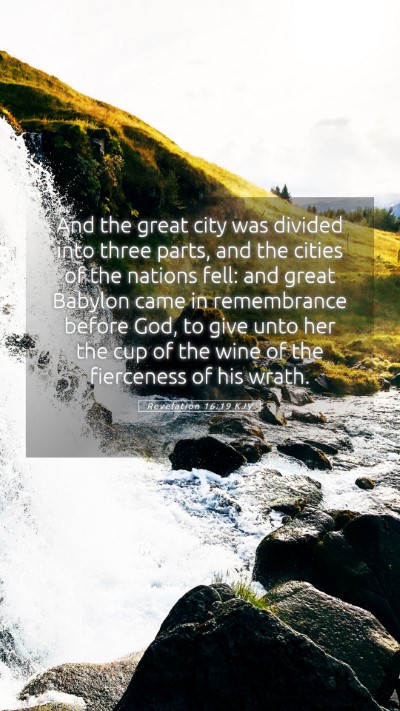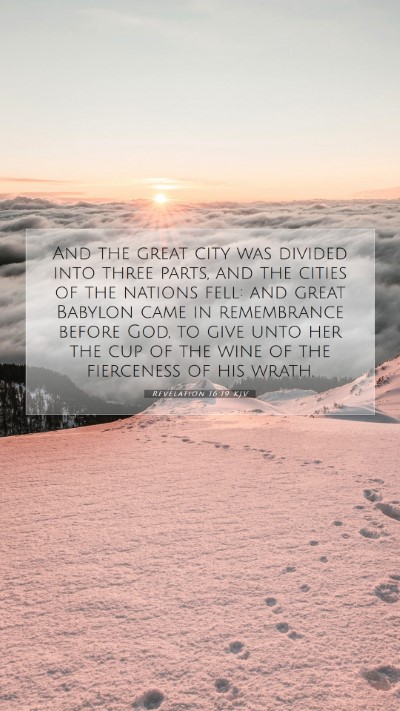Understanding Revelation 16:19
Revelation 16:19 is a profound verse in the Book of Revelation that emphasizes the final judgment and the ultimate fate of the world. The verse states:
"And the great city was divided into three parts, and the cities of the nations fell: and great Babylon came in remembrance before God, to give unto her the cup of the wine of the fierceness of his wrath."
Overview of the Verse
This verse depicts a critical moment during the final judgments that God pours out upon the earth. The imagery of the 'great city' likely refers to Babylon, symbolizing rebellion against God and moral corruption. The division into three parts may signify chaos and destruction, while the remembrance of Babylon suggests a time for divine retribution for its sins.
Bible Verse Meanings
The following insights are drawn from esteemed public domain commentaries to elucidate the verse's rich meanings:
- Matthew Henry: He emphasizes that the division of the great city symbolizes the ultimate breakdown of human institutions and corruption at the end of days. Henry notes that Babylon’s fall is not just physical but spiritual, signifying the end of evil's reign.
- Albert Barnes: Barnes explains that the ‘cup of the wine of the fierceness of his wrath’ is a metaphor for the severe judgment that God exacts on sin and rebellion. He highlights that this judgment is deserved and underscores the seriousness of ignoring divine warnings.
- Adam Clarke: Clarke interprets 'Babylon' as representative of all secular and ungodly systems opposed to God. He notes that the mention of the city's destruction serves as a warning to those who continue in sin, stressing that divine justice will eventually prevail.
Bible Verse Interpretations
Understanding Revelation 16:19 involves interpreting the rich metaphorical language prevalent in apocalyptic literature. The 'great city' signifies more than just a geographical location; it embodies the entirety of human rebellion against divine authority.
Symbolism and Theological Implications
The verse employs potent imagery that suggests:
- Divine Judgment: The destruction of Babylon represents God's teeming discontent with sin and rebellion.
- Finality of Judgment: The division of the great city into three parts symbolizes the completeness and certainty of divine judgment.
- Hope and Justice: Despite the severity of the passage, it holds hope for believers that evil will not prevail, and justice will be served.
Bible Study Insights
When studying this verse, consider the following:
- What does the imagery of 'Babylon' evoke in the wider context of Scripture?
- How does this verse relate to the themes of judgment and redemption in both the Old and New Testaments?
- In what ways can the concepts presented in Revelation 16:19 be applied in today's world?
Cross References
Revelation 16:19 relates to several other passages in Scripture that provide further context and understanding:
- Revelation 14:8: "And there followed another angel, saying, Babylon is fallen, is fallen..." - This verse emphasizes Babylon's impending doom.
- Jeremiah 51:7: "Babylon hath been a golden cup in the Lord's hand..." - This Old Testament parallel illustrates Babylon's symbolic significance.
- Revelation 18:2: "And he cried mightily with a strong voice, saying, Babylon the great is fallen..." - A further declaration of Babylon's fall.
Application of Revelation 16:19
To apply the lessons from Revelation 16:19, one might reflect on the following:
- Personal Reflection: Assessing one's life for areas of rebellion against God.
- Community Awareness: Engaging in discussions about societal issues reflecting 'Babylon' in modern contexts.
- Hope in Judgment: Understanding that divine judgment serves as both warning and hope for the faithful.
Conclusion
Revelation 16:19 is a powerful verse highlighting the themes of judgment, retribution, and ultimate hope embedded within divine justice. Through the insights provided by various commentaries, readers can deepen their understanding of this complex scripture, contributing to their broader Bible verse interpretations and studies.


